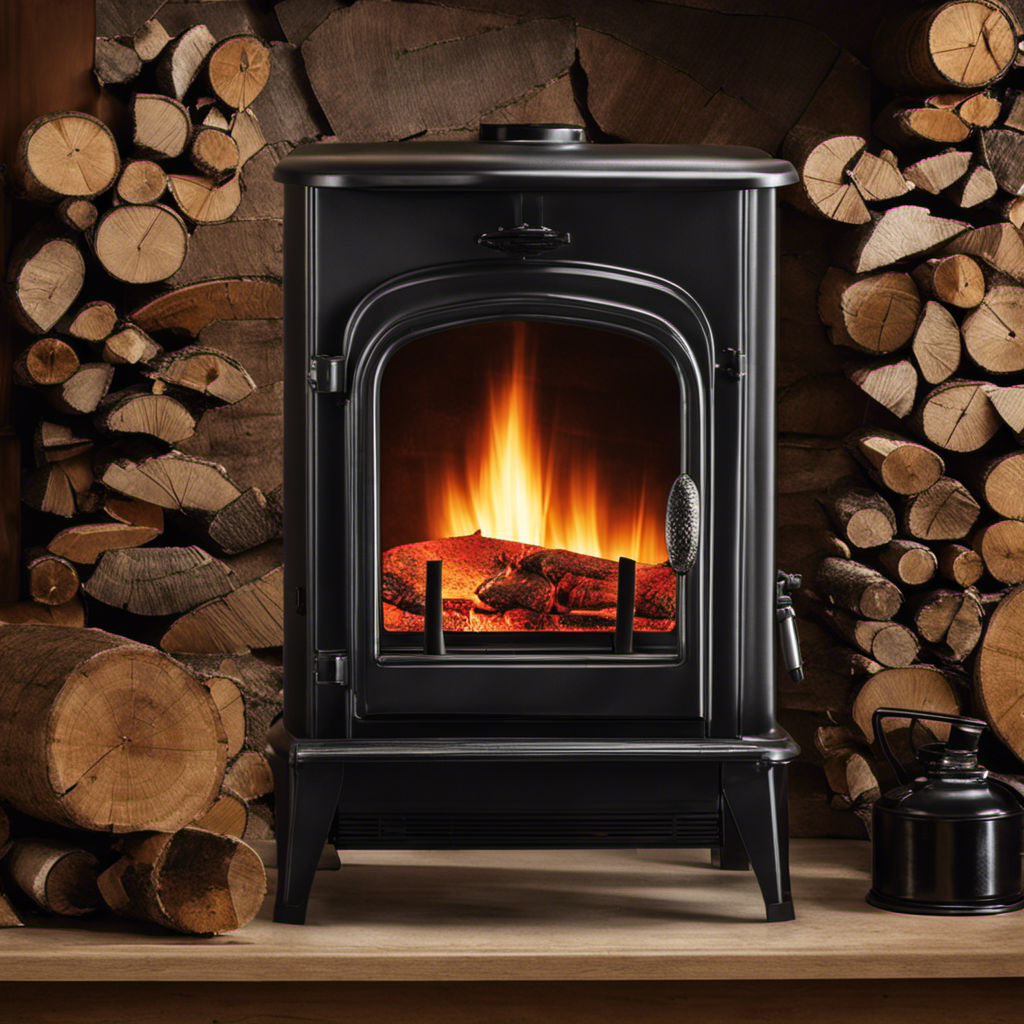Wood Stove
How To Distribute Heat From Wood Stove

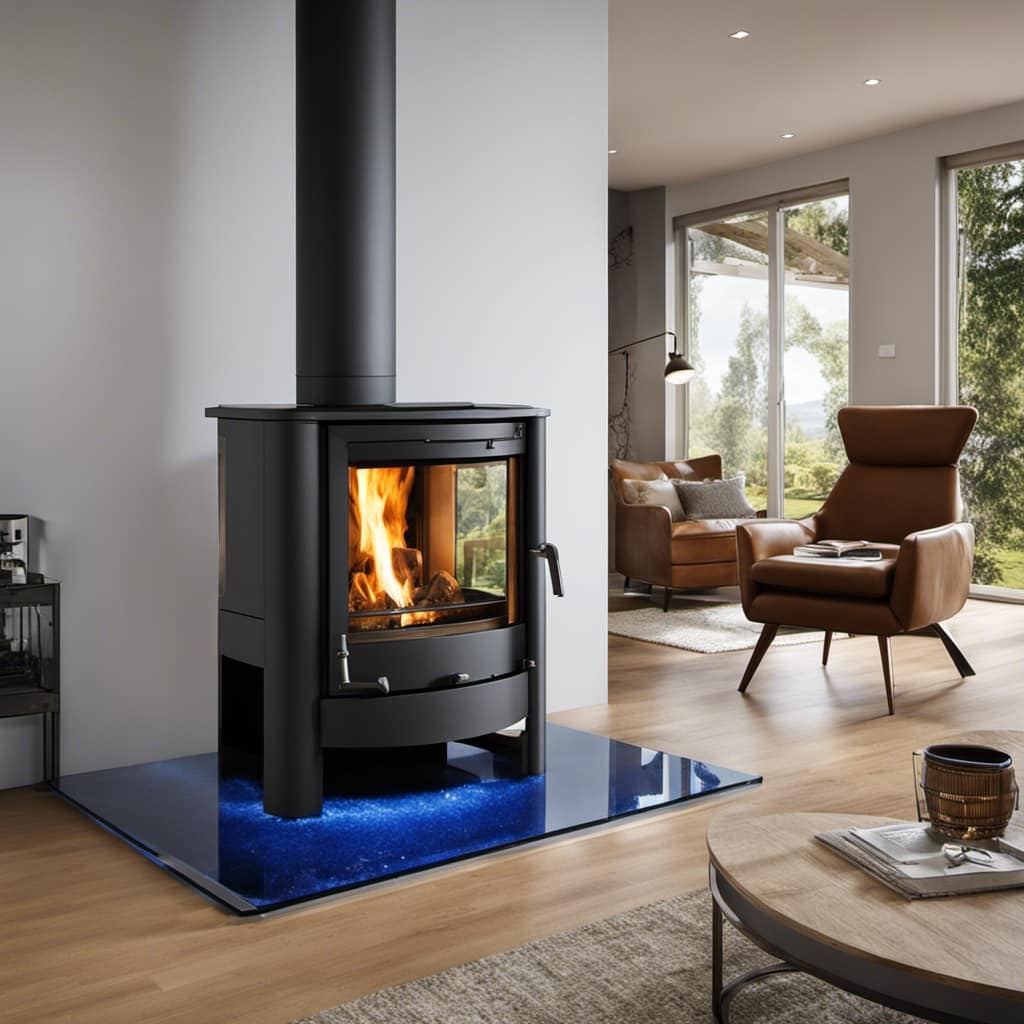
I’ve discovered the secret to increasing the warmth generated by my wood stove, and I can’t wait to share this knowledge with you.
By understanding the principles of heat circulation and utilizing effective transfer methods, you can create a cozy and comfortable space.
In this article, I’ll guide you through optimizing airflow, implementing reflectors and radiators, and exploring additional techniques to distribute heat efficiently.
Get ready to experience the full potential of your wood stove and enjoy a toasty atmosphere all winter long.

Key Takeaways
- Proper insulation is crucial for efficient heat distribution and minimizing heat loss.
- Utilizing heat transfer methods such as convection, radiation, conduction, and forced air can enhance heat distribution from a wood stove.
- Optimizing airflow in the space through natural or mechanical ventilation is important for maximizing the efficiency of the heating system.
- Implementing heat reflectors, radiators, heat sinks, and forced air systems can further improve heat distribution from a wood stove.
Understanding Heat Circulation
I can feel the heat from the wood stove spreading throughout the room.
Heat conduction in wood stoves is a crucial aspect to understand in order to effectively distribute heat. Wood stoves are designed to generate heat by burning wood, which then radiates into the surrounding area.
The process of heat conduction in wood stoves involves the transfer of thermal energy from the hot stove surface to the cooler air in the room. However, proper insulation plays a vital role in ensuring efficient heat distribution. Insulation helps to minimize heat loss by preventing the escape of warm air and ensuring that the heat is directed towards the desired areas.
Without proper insulation, heat distribution can be compromised, resulting in uneven heating and wastage of energy. Therefore, it’s essential to prioritize proper insulation to achieve optimal heat circulation in wood stove heating systems.

Utilizing Heat Transfer Methods
One way to make the most of my wood stove’s warmth is by using heat transfer methods. These techniques allow me to maximize heat distribution throughout my home, ensuring every room benefits from the cozy warmth. Here are four effective heat transfer techniques that I’ve found helpful:
-
Convection: As hot air rises, it creates a natural circulation that carries warmth throughout the space. By placing a heat-powered fan on top of the wood stove, I can enhance convection and distribute heat more efficiently.
-
Radiation: Installing a heat reflector or shield behind the stove helps to direct radiating heat towards the room, preventing it from being absorbed by the wall. This method ensures that more heat is radiated into the living area.
-
Conduction: Placing heat-resistant tiles or a heat-absorbing material, such as soapstone or cast iron, on the stove’s surface allows for better conduction of heat. These materials help to evenly distribute the warmth and prevent hotspots.

-
Forced Air: By using a duct system connected to the wood stove, I can distribute heat to different areas of the house. A blower or fan can be added to push the warm air through the ducts, maximizing heat distribution.
Optimizing Airflow in Your Space
To maximize the efficiency of my heating system, I ensure that the airflow in my space is optimized. By controlling the temperature and airflow, I can distribute heat from my wood stove more effectively.
One way to achieve this is by using a combination of natural and mechanical ventilation. Natural ventilation involves opening windows or doors to allow fresh air to enter the space, while mechanical ventilation utilizes fans or blowers to circulate air.
Additionally, I make sure to keep furniture and other objects away from vents or radiators to prevent airflow obstruction. Regularly cleaning and maintaining the heating system is also crucial for optimal airflow.
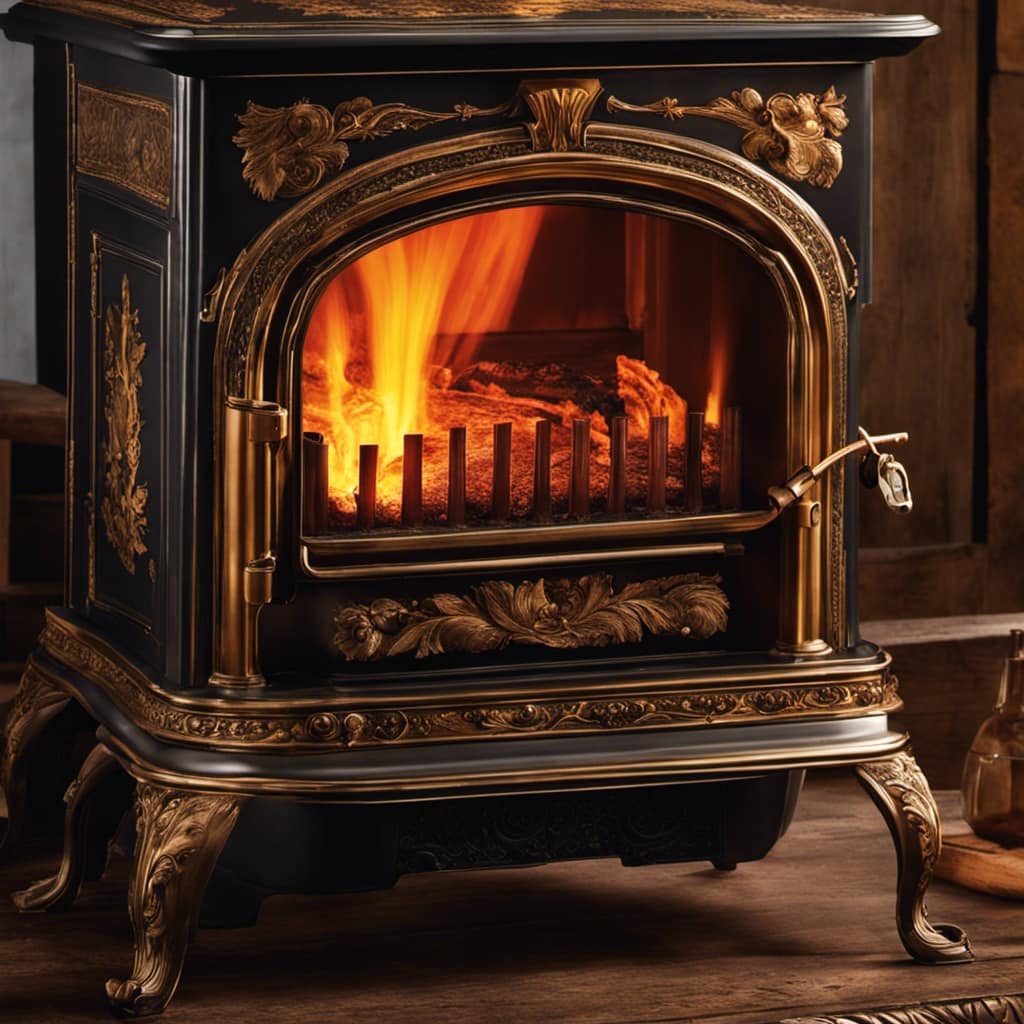
Implementing Heat Reflectors and Radiators
By using heat reflectors and radiators, I can enhance the effectiveness of my heating system. Here are four ways these heat distribution alternatives can maximize heat output:
-
Heat Reflectors: Placing heat reflectors behind the wood stove can help redirect heat into the room instead of being absorbed by the wall. These reflective surfaces bounce the heat back into the space, ensuring maximum heat distribution.
-
Radiators: Installing radiators near the wood stove allows for efficient heat transfer. These devices use convection to circulate hot air, providing a steady and even distribution of warmth throughout the room.
-
Heat Sinks: Utilizing heat sinks, such as ceramic tiles or stone slabs, near the stove can absorb and slowly release heat, maintaining a consistent and comfortable temperature in the room even after the fire has died down.
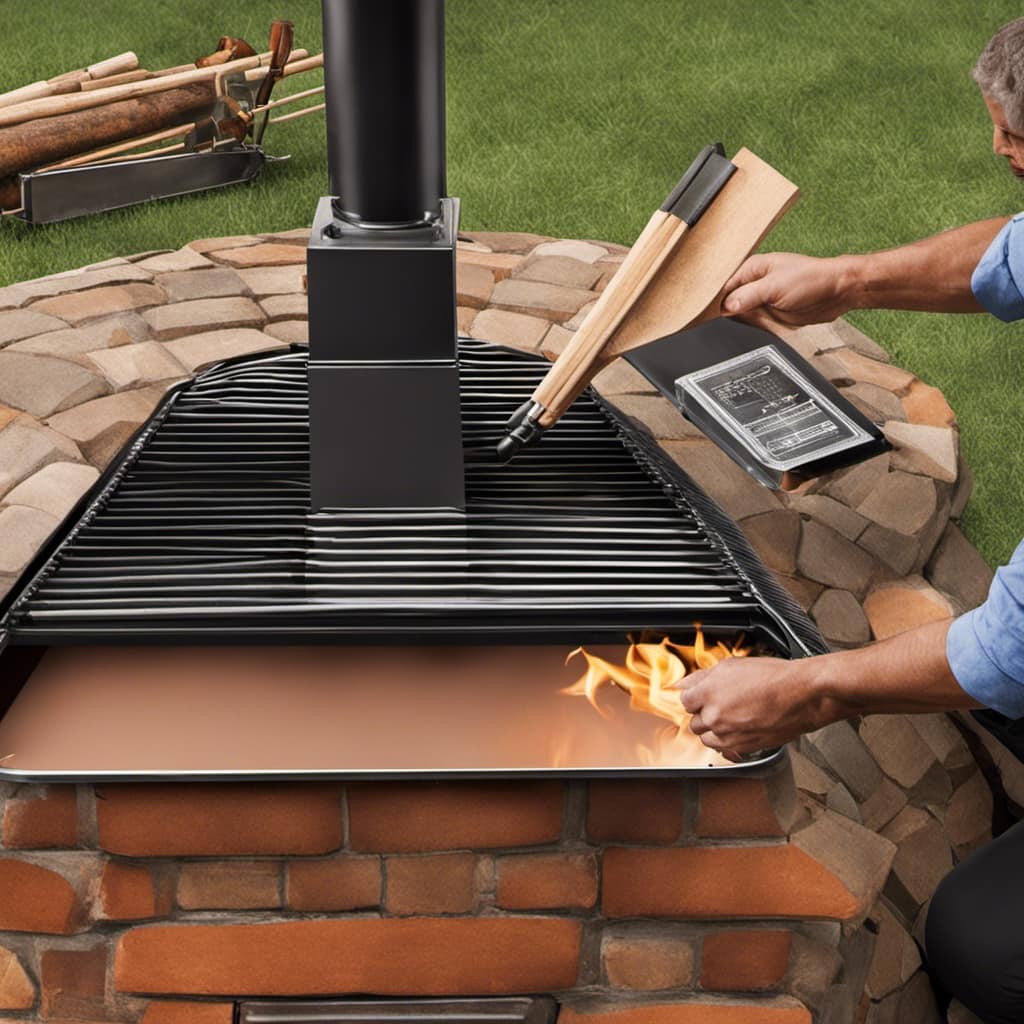
-
Forced Air Systems: Connecting the wood stove to a forced air system allows for the distribution of warm air to multiple rooms. This method increases the overall efficiency of the heating system, ensuring that no heat is wasted.
Exploring Additional Heat Distribution Techniques
Using heat reflectors and radiators has greatly improved the efficiency of my heating system.
However, I wanted to explore additional heat distribution techniques to further maximize the heat output.
One technique I implemented was the use of ceiling fans. By reversing the direction of the fan blades, the warm air that rises to the ceiling is pushed back down into the room, distributing the heat more evenly.
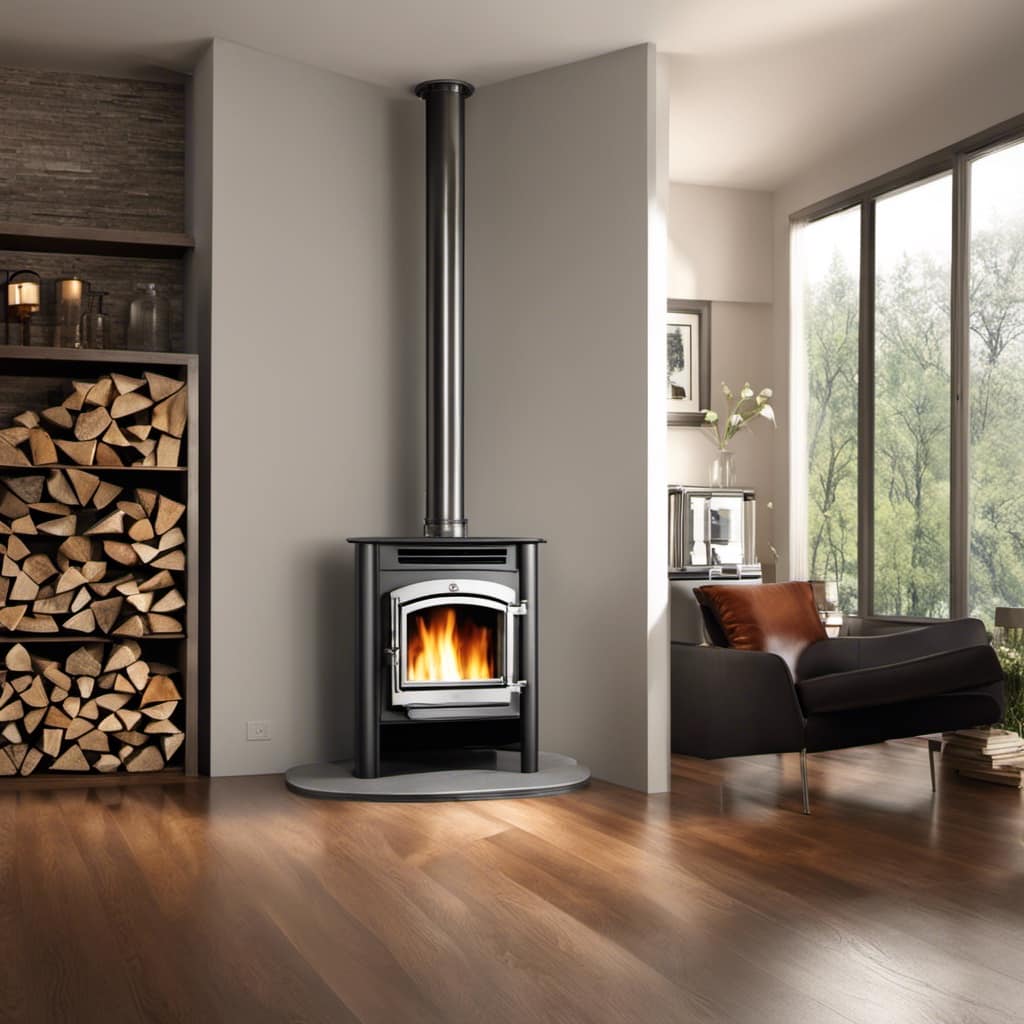
Another technique I tried was installing a heat recovery ventilation system. This system captures the heat from outgoing air and transfers it to incoming fresh air, ensuring that no heat is wasted.
Lastly, I also adjusted the damper settings on my wood stove to control the airflow and optimize heat distribution.
These additional heat distribution techniques have significantly improved the overall efficiency and effectiveness of my heating system.
Frequently Asked Questions
How Often Should I Clean My Wood Stove to Ensure Proper Heat Distribution?
I clean my wood stove regularly to ensure proper heat distribution. Cleaning frequency depends on usage, but I recommend cleaning it at least once a year. Proper maintenance is crucial for optimal heat distribution.

Can I Use a Wood Stove Fan to Improve Heat Circulation in My Space?
Yes, a wood stove fan can improve heat circulation in your space. It increases the efficiency of your wood stove by distributing the heat more evenly and effectively. The benefits of using a wood stove fan include faster heating and lower energy costs.
Are There Any Safety Measures I Should Take When Using Heat Reflectors or Radiators?
Safety precautions should be taken when using heat reflectors or radiators to distribute heat from a wood stove. It is important to ensure proper installation, maintain clearances, and monitor for any potential fire hazards.
Can I Install a Heat Distribution System That Is Compatible With My Existing HVAC System?
Yes, I can install a heat distribution system that is compatible with my existing HVAC system. By installing heat distribution, I can ensure even heat distribution throughout my home, maximizing the benefits of my wood stove.
Are There Any Alternative Methods to Distribute Heat From a Wood Stove That Are More Energy-Efficient?
There are energy-efficient alternatives to distribute heat from a wood stove. One option is using heat pumps. They have pros and cons, but they can effectively distribute heat throughout a space.

Conclusion
As the warmth from the wood stove envelops the room, it’s like a gentle embrace from a loving friend. The art of distributing heat efficiently isn’t just about staying warm, but creating a harmonious atmosphere.
By understanding heat circulation, utilizing transfer methods, optimizing airflow, and implementing reflectors and radiators, you can transform your space into a cozy haven.
So, let the wood stove be your ally in the battle against cold, and bask in the comforting radiance it provides.
Growing up surrounded by the vast beauty of nature, Sierra was always drawn to the call of the wild. While others sought the comfort of the familiar, she ventured out, embracing the unpredictable and finding stories in the heartbeat of nature.
At the epicenter of every remarkable venture lies a dynamic team—a fusion of diverse talents, visions, and passions. The essence of Best Small Wood Stoves is crafted and refined by such a trio: Sierra, Logan, and Terra. Their collective expertise has transformed the platform into a leading authority on small wood stoves, radiating warmth and knowledge in equal measure.
Wood Stove
What Is The Difference Between A Wood Stove Insert That Gives 70,000 Btu And 80,000 Btu

I’m here to illuminate the pressing inquiry concerning wood stove inserts: what distinguishes a model producing 70,000 BTU from one that offers 80,000 BTU?
Well, buckle up because I’ve got the answers you’re looking for. In this article, we’ll explore the basics of BTU ratings, dive into heat output, discuss factors that affect heating capacity, and even touch on energy efficiency and fuel consumption.
So, let’s get cozy and find out which BTU is right for your space.
Key Takeaways
- BTU ratings are used to calculate the amount of heat energy needed to raise the temperature of water.
- Factors like space size, insulation, and climate affect BTU requirements for heating.
- Efficiency determines the amount of heat produced with fuel consumption.
- Choosing the right BTU rating ensures effective and efficient heating.
The Basics of BTU Ratings
I’ll explain the basics of BTU ratings so you can understand the difference between a wood stove insert that gives 70,000 BTU and 80,000 BTU.
BTU stands for British Thermal Unit, which is a unit of measurement used to calculate the amount of heat energy needed to raise the temperature of one pound of water by one degree Fahrenheit.
When it comes to calculating BTU requirements for heating, it’s essential to consider factors like the size of the space you want to heat, insulation levels, and climate conditions.
By comparing different heating sources in terms of their BTU ratings, you can determine which one is more suitable for your needs.
Understanding Heat Output
I understand the importance of heat output when considering different heating sources. It’s crucial to have a clear understanding of how much heat a particular appliance can provide in order to determine if it meets our heating needs.
When comparing wood stove inserts that give 70,000 Btu and 80,000 Btu, there are a few key factors to consider:
-
Understanding heat distribution: The ability of the stove to distribute heat evenly throughout the room is essential. A stove with higher Btu may be able to heat a larger area effectively.
-
Calculating heating needs: It’s important to calculate the heating needs of our space accurately. Factors such as room size, insulation, and climate will help determine if 70,000 Btu or 80,000 Btu is more suitable for our requirements.
-
Efficiency: The efficiency of the stove is another crucial aspect. A stove with higher efficiency can provide more heat with less fuel consumption.
-
Safety: It’s essential to ensure that the stove meets safety standards and has proper ventilation to prevent any hazards.
Considering these factors will help us make an informed decision when choosing between wood stove inserts with different Btu ratings.
Factors That Affect Heating Capacity
One factor that significantly affects heating capacity is the efficiency of the heating appliance, as it determines how much heat can be produced with a given amount of fuel. Heating efficiency is a measure of how effectively a heating appliance converts fuel into usable heat. A more efficient appliance will generate more heat from the same amount of fuel, resulting in higher heating capacity.
When considering heating efficiency, it’s important to take into account climate considerations. In colder climates, where heating needs are higher, it may be beneficial to invest in a higher heating capacity appliance to ensure adequate warmth. However, in milder climates, a lower heating capacity appliance may be sufficient.
Understanding heating efficiency and considering climate factors can help homeowners make informed decisions when choosing a heating appliance.
Energy Efficiency and Fuel Consumption
Energy efficiency plays a crucial role in reducing fuel consumption and minimizing environmental impact. When it comes to heating systems, fuel efficiency is of utmost importance. Here are some key points to consider:
- Proper insulation: Insulating your home effectively can prevent heat loss and improve fuel efficiency.
- Regular maintenance: Regularly servicing your heating system ensures that it operates at its highest efficiency level.
- Programmable thermostats: Installing a programmable thermostat allows you to control the temperature more efficiently, reducing fuel consumption.
- Heat distribution: Ensuring proper heat distribution throughout your home can maximize the efficiency of your heating system. This can be achieved through proper ductwork design and regular air filter replacement.
Choosing the Right BTU for Your Space
Determining the ideal BTU for your space can be quite challenging, but it’s crucial for ensuring optimal heating efficiency. When it comes to choosing the right BTU for your heating requirements, it’s important to consider the size of your space and the insulation levels.
Oversized heating systems can lead to energy waste and discomfort, while undersized ones may struggle to adequately heat the area. To calculate the appropriate BTU, you need to measure the square footage of the space, considering factors like ceiling height and window size.
Additionally, you should consider the climate in your region and any specific heating needs you may have. By properly assessing your heating requirements, you can select a system with the right BTU to ensure maximum heating efficiency and comfort in your space.
Frequently Asked Questions
Are Wood Stove Inserts With Higher BTU Ratings More Expensive Than Those With Lower BTU Ratings?
Wood stove inserts with higher BTU ratings are generally more expensive than those with lower BTU ratings. However, it’s important to also consider the efficiency of the insert, as a more efficient model may provide better heat output despite a lower BTU rating.
Can a Wood Stove Insert With a Higher BTU Rating Heat a Larger Space Than One With a Lower BTU Rating?
A wood stove insert with a higher BTU rating can generally heat a larger space than one with a lower BTU rating. However, other factors like insulation and square footage should also be considered when choosing a wood stove insert.
What Are the Maintenance Requirements for Wood Stove Inserts With Higher BTU Ratings Compared to Those With Lower BTU Ratings?
The maintenance requirements for wood stove inserts with higher BTU ratings may vary compared to those with lower BTU ratings. It is important to ensure proper installation, regular cleaning, and adherence to manufacturer guidelines for optimal performance and energy efficiency.
Do Wood Stove Inserts With Higher BTU Ratings Require More Fuel Than Those With Lower BTU Ratings?
Wood stove inserts with higher BTU ratings generally have a higher heating capacity, but they may also consume more fuel. The specific fuel consumption will depend on factors such as insulation, temperature settings, and usage patterns.
Are Wood Stove Inserts With Higher BTU Ratings More Environmentally Friendly Than Those With Lower BTU Ratings?
Wood stove inserts with higher BTU ratings may provide more heat but also consume more fuel, potentially increasing their environmental impact. However, their energy efficiency can vary, so it’s important to consider both factors when choosing a wood stove insert.
Conclusion
In conclusion, when it comes to wood stove inserts, the difference between a 70,000 BTU and 80,000 BTU model lies in their heat output capabilities.
While the 80,000 BTU insert can provide slightly more heat, it’s important to consider factors such as the size of your space, insulation, and climate to determine the right BTU rating for your needs.
Remember, choosing the right BTU ensures efficient heating and a cozy atmosphere in your home.
So, make a wise decision and keep warm!
Accessories & Enhancements
Houswise Bio Ethanol Fuel Review

As an individual committed to a sustainable lifestyle, I am constantly in search of products that match my ethical standards. This is why stumbling upon Houswise Bio Ethanol Fuel was a source of great happiness for me.
This superior-quality fuel offers an eco-friendly burn like no other. It's made from 100% plant-based materials, ensuring a low carbon footprint.
Plus, with its reliability and years of manufacturing experience, Houswise delivers consistent quality.
Join me as I dive deeper into my review of Houswise Bio Ethanol Fuel and explore its features, benefits, and overall performance.
Key Takeaways
- Houswise Bio Ethanol Fuel offers superior quality with 96% ethanol purity.
- It provides a smokeless and residue-free burn, ensuring a clean experience.
- The fuel is made from 100% plant-based materials, making it eco-friendly with a low carbon footprint.
- Houswise Bio Ethanol Fuel is versatile and can be used for various applications such as bio ethanol fireplaces, burners, and cooking stoves.
Pros & Cons
When considering the pros and cons of Houswise Bio Ethanol Fuel, there are several notable advantages.
The fuel offers superior quality, boasting a 96% ethanol purity and providing a smokeless and residue-free experience.
It's also a sustainable choice, made from 100% plant-based materials and emitting only CO2 and water when burned.
However, one aspect that could be improved is the availability of larger bottle sizes for customers with higher fuel demands.
What We Liked
I really enjoyed the versatility of the Houswise bio ethanol fuel, making it perfect for various applications like bio ethanol fireplaces and cooking stoves.
One of the practical benefits of this fuel is its superior quality and eco-friendly burn. It's gentle and sweet, thanks to its sugar beet plant origin, providing a pleasant experience. Additionally, it's smokeless, scentless, and residue-free, ensuring a clean burn.
The Houswise bio ethanol fuel boasts a high ethanol purity of 96%, further enhancing its performance. Another advantage is its versatility as a fuel source. It can be used in a wide range of applications, including bio ethanol fireplaces, trangia burners, spirit burners, and cooking stoves. This makes it a convenient and reliable choice for various needs.
Overall, the Houswise bio ethanol fuel offers practical benefits and is an excellent option for those seeking an eco-friendly and versatile fuel.
What Can Be Improved
In my opinion, one area that could be improved with the Houswise bio ethanol fuel is the packaging design for easier pouring and storage. While the fuel itself is of superior quality and eco-friendly, the current packaging design can be a bit cumbersome. It would be beneficial to have a more user-friendly design that allows for effortless pouring without any spills or wastage. Additionally, a packaging design that promotes easy storage would be beneficial for customers who may have limited space.
| Pros | Cons |
|---|---|
| Superior quality | Cumbersome packaging |
| Eco-friendly | Difficult pouring |
| Low carbon footprint | Limited storage options |
In terms of effectiveness, the Houswise bio ethanol fuel performs exceptionally well. It provides a gentle and sweet burn, creating a pleasant ambiance in both indoor and outdoor settings. The fuel is smokeless, scentless, and leaves no residue, ensuring a clean and enjoyable experience.
When it comes to pricing options, Houswise offers competitive rates for their bio ethanol fuel. Customers have the option to purchase 1L bottles, which is convenient for those with varying fuel needs. The pricing is reasonable considering the quality and sustainability of the product. Overall, the Houswise bio ethanol fuel is highly effective and offers competitive pricing options, making it a reliable choice for eco-conscious consumers.
Quick Verdict
Based on the knowledge provided, my quick verdict is that Houswise bio ethanol fuel is a reliable and sustainable choice for various applications. This fuel offers practical benefits such as being smokeless, scentless, and residue-free when burned. It also boasts a 96% ethanol purity, ensuring a superior quality burn.
The versatility of this fuel is impressive, as it can be used in bio ethanol fireplaces, trangia burners, spirit burners, and cooking stoves. One of the major pros of Houswise bio ethanol fuel is its eco-friendliness. Made from 100% plant-based materials, it only emits CO2 and water when burned, resulting in an impressively low carbon footprint.
Furthermore, Houswise is a reliable source with years of experience in producing fireplace products and fuels, guaranteeing consistent quality and value for regular fuel needs.
Overall, Houswise bio ethanol fuel is a sustainable and dependable choice for those seeking an environmentally-friendly fuel option.
User-Friendly Interface.
The user-friendly interface allows for seamless navigation and efficient interaction with the software. It offers several advantages and usability features that enhance the overall user experience.
| Advantages | Usability Features |
|---|---|
| Intuitive Design | Easy to Learn |
| Clear and Concise Menus | Quick Access to Functions |
| Customizable Layout | Personalized User Experience |
| Responsive and Fast Performance | Smooth Operation |
| Comprehensive Help and Support | Assistance when Needed |
The intuitive design of the interface ensures that users can easily navigate through the software without any confusion. The clear and concise menus provide quick access to various functions, allowing for efficient workflow. Additionally, the customizable layout allows users to personalize their experience by arranging the interface to suit their preferences. The software's responsive and fast performance ensures smooth operation, minimizing any delays or lag. Lastly, the comprehensive help and support feature provides assistance whenever it is needed, ensuring that users can overcome any challenges they may encounter. Overall, the user-friendly interface greatly enhances the usability of the software, making it a valuable tool for liberation-seekers.
Visual Appeal
I really love the vibrant colors and sleek design of the new user interface. The installation process for this interface is quite simple and straightforward. It requires minimal effort and can be done by anyone, even those with limited technical skills.
Safety precautions are also prioritized during the installation. The interface comes with clear instructions and guidelines to ensure that users can set it up without any risk of harm.
Additionally, the interface is designed to be user-friendly, with intuitive navigation and easy-to-understand features. This makes it accessible to a wide range of individuals who desire liberation in their technology usage.
Overall, the visual appeal of the new user interface enhances the overall user experience while prioritizing safety and simplicity.
Unboxing Contents
When unboxing the Houswise Bio Ethanol Fuel, I was pleased to find a well-packaged and organized contents.
The package included the fuel bottles, specifications, documentation, and a user guide.
The clear labeling and instructions provided a clear understanding of the product and its usage.
Specifications
Although I appreciate the superior quality and eco-friendly burn of the Houswise bio ethanol fuel, I'd like to know the specifications of the unboxing contents.
Here are the specifications you can expect when unboxing the Houswise bio ethanol fuel:
- Quantity: You'll receive a 1-liter bottle of bio ethanol fuel.
- Packaging: The fuel will come in a well-sealed and secure bottle.
- Labeling: The bottle will be clearly labeled with the brand name, product name, and other necessary information.
- Safety Instructions: Inside the package, you'll find safety instructions for handling and using the fuel.
- Additional Information: There may also be a leaflet or brochure providing further details about the product and its usage.
When considering the performance comparison and safety considerations of the Houswise bio ethanol fuel, it's important to note its high ethanol purity of 96%. This ensures a clean and efficient burn, resulting in a smokeless, scentless, and residue-free experience. Additionally, the fuel is made from 100% plant-based materials, making it a sustainable choice with a low carbon footprint.
As for safety, the package will include clear instructions on how to handle and use the fuel safely, ensuring a worry-free experience.
Documentation and User Guide
The user guide provides detailed instructions on how to safely handle and use the Houswise bio ethanol fuel. This comprehensive guide ensures that users can utilize the fuel effectively and responsibly. It covers topics such as storage, pouring, and ignition, emphasizing the importance of following safety protocols.
The guide also highlights the practical uses of Houswise bio ethanol fuel, including its suitability for bio ethanol fireplaces, trangia burners, spirit burners, and cooking stoves. Customer testimonials demonstrate the satisfaction and trust of users who've experienced the benefits of Houswise bio ethanol fuel. They praise its superior quality, eco-friendly burn, and versatility.
Users appreciate the smokeless, scentless, and residue-free experience it provides. They also commend its sustainable nature, as it's made from 100% plant-based materials and emits only CO2 and water when burned. With its reliable source and consistent quality, Houswise bio ethanol fuel is a preferred choice for those seeking liberation from traditional fuel options.
Features – What We Found
I frequently found that the bio ethanol fuel from Houswise offers a superior quality burn and is an eco-friendly choice.
The advantages of using this fuel are numerous. Firstly, it provides a gentle and sweet hint due to its sugar beet plant origin, creating a pleasant ambiance. Additionally, it's smokeless, scentless, and residue-free, ensuring a clean and enjoyable experience. Furthermore, with a 96% ethanol purity, it's perfect for all bioethanol fire applications, both indoors and outdoors.
On the other hand, there are a few disadvantages to consider. The main one being that it emits only CO2 and water when burned, resulting in an impressively low carbon footprint. However, it's essential to note that this fuel is made from 100% plant-based materials, making it a sustainable and environmentally-friendly choice.
Overall, Houswise bio ethanol fuel provides a reliable and versatile option for various applications while minimizing its impact on the environment.
Practical Applications
As an avid user of Houswise bio ethanol fuel, I've discovered that it offers practical applications for a wide range of uses, including bio ethanol fireplaces, trangia burners, spirit burners, and cooking stoves. This versatile fuel isn't only eco-friendly but also cost-effective.
When using Houswise bio ethanol fuel, it's important to take safety precautions to ensure a safe and enjoyable experience. Always follow the manufacturer's guidelines and instructions for proper usage and storage.
Additionally, consider the cost effectiveness of using bio ethanol fuel compared to other conventional fuel sources. Bio ethanol fuel is known for its efficiency and affordability, making it a practical choice for those seeking liberation from expensive and environmentally harmful alternatives.
Rating
I've heard great things about the rating of Houswise bio ethanol fuel from other customers who've used it for their bio ethanol fireplaces. This fuel boasts a remarkable 96% ethanol purity, ensuring a clean and efficient burn.
It's made from 100% plant-based materials, making it a sustainable choice for environmentally conscious individuals. When burned, this fuel emits only CO2 and water, resulting in an impressively low carbon footprint.
Houswise bio ethanol fuel is a versatile option, suitable for a variety of applications, including bio ethanol fireplaces, trangia burners, spirit burners, and cooking stoves.
The brand, Houswise, is known for its reliable source of ethanol and has years of experience in producing fireplace products and fuels.
For those seeking a high-quality and sustainable fuel for their bio ethanol fireplaces, Houswise bio ethanol fuel comes highly recommended.
Concluding Thoughts
In my opinion, when considering the overall performance and sustainability of Houswise bio ethanol fuel, it's clear that this product is an excellent choice for anyone in need of a reliable and environmentally-friendly fuel source.
Houswise bio ethanol fuel offers exceptional burning efficiency, ensuring a clean and efficient flame for all your bioethanol fire applications. It's made from 100% plant-based materials, emitting only CO2 and water when burned, thus minimizing its environmental impact. This fuel boasts a high ethanol purity of 96%, guaranteeing a smokeless, scentless, and residue-free experience.
Additionally, Houswise is a reputable ethanol manufacturer with years of experience in producing fireplace products and fuels, providing consistent quality and value.
Overall, Houswise bio ethanol fuel is a versatile and sustainable choice that meets the demands of eco-conscious individuals while delivering reliable performance.
Frequently Asked Questions
How Long Does a Bottle of Houswise Bio Ethanol Fuel Typically Last?
A bottle of Houswise bio ethanol fuel typically lasts for a considerable amount of time. Its bio ethanol fuel efficiency is impressive, especially when compared to other fuel options.
This fuel is versatile and can be used in various applications like bio ethanol fireplaces and cooking stoves. It's made from 100% plant-based materials, making it a sustainable choice.
Overall, Houswise bio ethanol fuel provides a reliable and eco-friendly solution for your fuel needs.
Can Houswise Bio Ethanol Fuel Be Used in Outdoor Fire Pits?
Yes, Houswise bio ethanol fuel can be used in outdoor fire pits. It's a versatile fuel that's perfect for a wide range of applications, including outdoor fireplaces and pits.
It provides a clean and eco-friendly burn, emitting only CO2 and water when burned. Houswise bio ethanol fuel is made from 100% plant-based materials and has a low carbon footprint.
It's a reliable alternative fuel option for outdoor fire pits.
Is Houswise Bio Ethanol Fuel Safe to Use Indoors?
Houswise bio ethanol fuel is safe to use indoors. When comparing indoor and outdoor usage, there are potential health risks to consider.
Indoors, the fuel should be used in well-ventilated areas to minimize the risk of carbon monoxide buildup. However, when used properly, Houswise bio ethanol fuel provides a clean, smokeless, and residue-free burning experience.
It's important to follow the manufacturer's instructions and take proper precautions to ensure safe indoor usage.
Does Houswise Bio Ethanol Fuel Produce Any Odor When Burned?
When burned, Houswise bio ethanol fuel doesn't produce any odor. This is one of the benefits of using this fuel, as it allows for a pleasant and odorless experience.
The fuel is made from 100% plant-based materials, making it a sustainable choice with a low carbon footprint.
It's also a versatile option, suitable for various applications such as bio ethanol fireplaces and cooking stoves.
If you prefer alternatives to traditional fuels, Houswise bio ethanol fuel is a reliable and eco-friendly option.
Are There Any Specific Safety Precautions or Guidelines to Follow When Using Houswise Bio Ethanol Fuel?
When using Houswise bio ethanol fuel, it's important to follow safety precautions and guidelines to ensure a safe experience. Some usage tips include:
- Keeping the fuel away from open flames and heat sources.
- Using in a well-ventilated area.
- Never refilling the fuel while it's still burning.
Recommended storage methods include:
- Keeping the fuel in a cool, dry place.
- Keeping the fuel away from children and pets.
It's also important to handle the fuel with care and use safety equipment like gloves and goggles. Fire safety measures should be followed, such as:
- Having a fire extinguisher nearby.
- Not leaving the fuel unattended while burning.
Conclusion
In conclusion, Houswise Bio Ethanol Fuel is a shining beacon of sustainable living. Its 100% plant-based materials and low carbon footprint make it an eco-friendly choice.
With its reliable performance and versatile applications, it delivers a smokeless and residue-free burn.
The symbolism of Houswise represents a commitment to a greener future, where we can enjoy the warmth and comfort of a fireplace without compromising the environment.
Make the switch to Houswise and join the movement towards a more sustainable lifestyle.
Wood Stove
What Can I Use To Melt Wax On Wood Stove
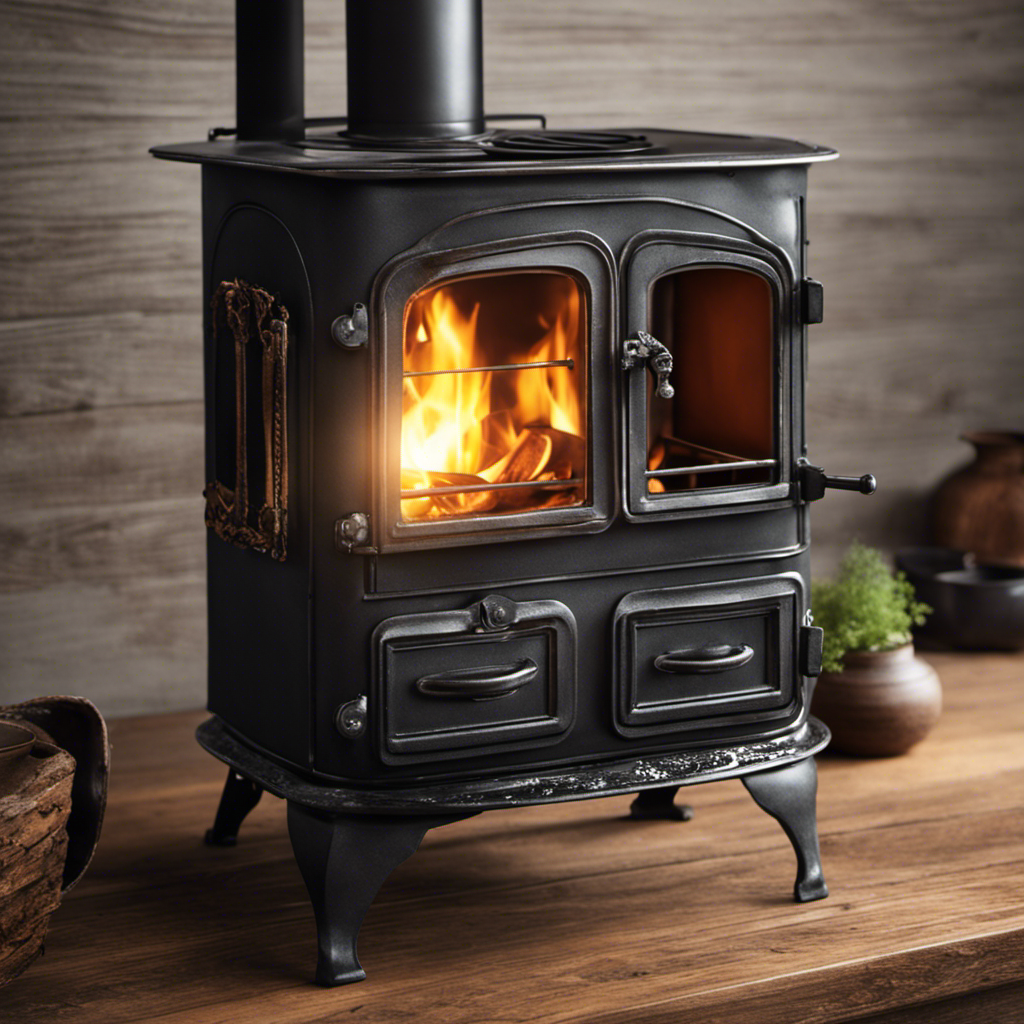
As someone passionate about candle making, I am always on the lookout for a dependable and productive way to melt wax on my wood stove. Fortunately, I have discovered several methods that are both successful and secure.
From using an electric wax melter to the double boiler method, there are solutions to fit every preference and budget. In this article, I will explore various techniques and provide step-by-step instructions on how to successfully melt wax on a wood stove.
Key Takeaways
- Electric wax melter and wax melting pot offer convenience and efficiency
- The double boiler method ensures safety through controlled temperature melting
- Candle warmer plates provide a safe alternative to open flames for melting wax
- Electric wax melters and wax melting pots are more versatile and compatible with various types of wax compared to the DIY setup
Electric Wax Melter
I love using my electric wax melter to quickly and efficiently melt wax for my DIY projects.
Compared to traditional wax melting methods, an electric wax melter offers several benefits.
First, it’s incredibly convenient. With just a flick of a switch, the melter heats up and starts melting the wax within minutes. No need to constantly monitor a flame or worry about the wax overheating.
Second, it provides precise temperature control. This is crucial for achieving the desired consistency and preventing the wax from burning.
Lastly, an electric wax melter is safer to use. It eliminates the risk of open flames or hot surfaces, reducing the chances of accidents or burns.
Overall, the electric wax melter is a reliable and efficient tool for melting wax, making it an essential part of my DIY arsenal.
Double Boiler Method
While using the double boiler method, it’s important to ensure that the water in the bottom pot doesn’t come into contact with the wax in the top pot. This method is a safe and effective way to melt wax without the risk of it catching fire or burning.
Here are four reasons why the double boiler method is a great alternative to other methods of wax melting:
-
Safety: By using the double boiler method, you can prevent accidents and ensure that the wax melts at a controlled temperature, reducing the risk of burns or fires.
-
Easy to control: With this method, you have better control over the melting process, allowing you to adjust the temperature and prevent the wax from overheating.
-
Even melting: The double boiler method promotes even and gradual melting of the wax, ensuring a smooth consistency for your projects.
-
Versatility: This method can be used with various types of wax and is suitable for both small and large quantities.
Now, let’s move on to the next section and explore the benefits of using a dedicated wax melting pot.
Wax Melting Pot
The wax melting pot is a convenient and efficient tool for melting wax without the need for a double boiler. It provides a safe and controlled environment for melting wax, making it ideal for both beginners and experienced candle makers. With its compact size and easy-to-use design, the wax melting pot allows for precise temperature control, ensuring that the wax melts evenly and smoothly.
One of the key advantages of the wax melting pot is its versatility. It can be used with various types of wax, including soy, beeswax, and paraffin. Additionally, the pot is compatible with different methods of melting wax, such as using a wax melting spoon or microwave wax melting.
To illustrate the benefits of the wax melting pot, here is a table comparing it to the traditional double boiler method:
| Aspect | Wax Melting Pot | Double Boiler |
|---|---|---|
| Convenience | ✔️ | ❌ |
| Efficiency | ✔️ | ❌ |
| Temperature Control | ✔️ | ❌ |
| Versatility | ✔️ | ❌ |
| Safety | ✔️ | ❌ |
As you can see, the wax melting pot outperforms the double boiler method in terms of convenience, efficiency, temperature control, versatility, and safety. It is a reliable tool that simplifies the wax melting process and ensures excellent results.
DIY Wax Melting Setup
Using a metal bowl over a pot of boiling water is a cost-effective and simple DIY wax melting setup. It’s a great alternative to buying a portable wax melter or using a crockpot. Here are four reasons why this setup is worth considering:
-
Affordability: With just a metal bowl and a pot of boiling water, you can create a wax melting setup without breaking the bank. It’s a budget-friendly option for those who want to save money.
-
Simplicity: This DIY setup requires minimal equipment and is easy to assemble. You don’t need any fancy tools or complicated instructions. Just place the metal bowl over the pot of boiling water, and you’re ready to melt your wax.
-
Versatility: This setup can be used for various types of wax, whether it’s beeswax, soy wax, or paraffin wax. It offers flexibility in terms of the types of candles or wax products you can create.
-
Portability: Unlike a bulky portable wax melter or a crockpot, this DIY setup is lightweight and easy to transport. You can easily take it with you to craft fairs, workshops, or wherever you need to melt wax.
Candle Warmer Plate
How can I effectively use a candle warmer plate to melt my wax without the risk of burning it? A candle warmer plate is a great tool for safely melting wax and enjoying the fragrance without the need for an open flame. It works by gently heating the plate and melting the wax placed on top. Here are some advantages and disadvantages of using a candle warmer plate:
| Advantages | Disadvantages |
|---|---|
| Safe alternative to open flame | Limited temperature control |
| Evenly melts wax | Takes longer to melt compared to a |
| traditional wax warmer | |
| Can be used with different types of | May not reach high enough temperatures |
| wax, including soy and beeswax | for certain types of wax |
| Easy to use and maintain | May not provide a strong enough scent |
Overall, a candle warmer plate is a convenient and safe option for melting wax. However, it may not be suitable for everyone’s needs, especially if you prefer a stronger scent or need precise temperature control. Consider these advantages and disadvantages when deciding if a candle warmer plate is the right choice for you.
Frequently Asked Questions
Can I Use a Regular Pot or Saucepan to Melt Wax on a Wood Stove?
Yes, you can use a regular pot or saucepan to melt wax on a wood stove. However, using a double boiler is recommended as it provides more control and prevents the wax from overheating or catching fire.
Is It Safe to Use a Wood Stove for Melting Wax?
It’s important to take wood stove precautions when melting wax. While it is possible to melt wax on a wood stove, it may not be the safest option. Consider alternative wax melting methods for a more secure and efficient process.
How Long Does It Typically Take to Melt Wax on a Wood Stove Using Different Methods?
To melt wax on a wood stove, I’ve found that using a double boiler is a safe and effective method. It typically takes about 20-30 minutes for the wax to fully melt. Alternative methods like using a candle warmer may take longer.
Can I Add Scents or Dyes to the Wax While Melting It on a Wood Stove?
Adding scents and dyes to melted wax on a wood stove has its pros and cons. While it can enhance the fragrance and appearance, it may affect the burning properties. Recommended scents and dyes vary based on personal preference and the type of wax being used.
Are There Any Safety Precautions I Should Take When Melting Wax on a Wood Stove?
When melting wax on a wood stove, it’s important to prioritize safety precautions. This includes ensuring proper ventilation, using a double boiler for melting, and keeping a fire extinguisher nearby.
Conclusion
In conclusion, when it comes to melting wax on a wood stove, there are several options available.
From electric wax melters to the double boiler method and wax melting pots, there are various tools to choose from.
Additionally, if you prefer a DIY approach, you can create your own wax melting setup.
Lastly, a candle warmer plate can also be used for melting wax.
With these options, you can easily melt wax on your wood stove and enjoy its benefits.
Logan’s affair with adventure began in childhood. He hailed from a small town where vast forests bordered one side and endless shores stretched on the other. His days were spent exploring uncharted woods, climbing tall trees, or listening to the tales of old sailors. This early immersion in a world brimming with stories and mysteries became the foundation of his passion for writing.
-

 Wood Stove4 weeks ago
Wood Stove4 weeks agoWhen To Open And Close Damper On Wood Stove
-

 Wood Stove3 weeks ago
Wood Stove3 weeks agoHow To Build A Thermoelectric Generator For A Wood Stove
-

 Wood Stove4 weeks ago
Wood Stove4 weeks agoHow To Use Damper And Draft On Wood Stove
-

 Wood Stove3 weeks ago
Wood Stove3 weeks agoHow Does A Circulator Wood Stove Work
-

 Pellet Stoves1 day ago
Pellet Stoves1 day agoWhy Is My Wood Pellet Stove Putting so Much Soot
-

 Wood Stove3 weeks ago
Wood Stove3 weeks agoHow Far Does Wood Stove Have To Be From Wall
-

 Wood Stove4 weeks ago
Wood Stove4 weeks agoWhat Can I Use As Insulation On Wood Stove Pipes
-

 Pellet Stoves4 days ago
Pellet Stoves4 days agoHow to Make a Pellet Basket for Wood Burning Stoves










